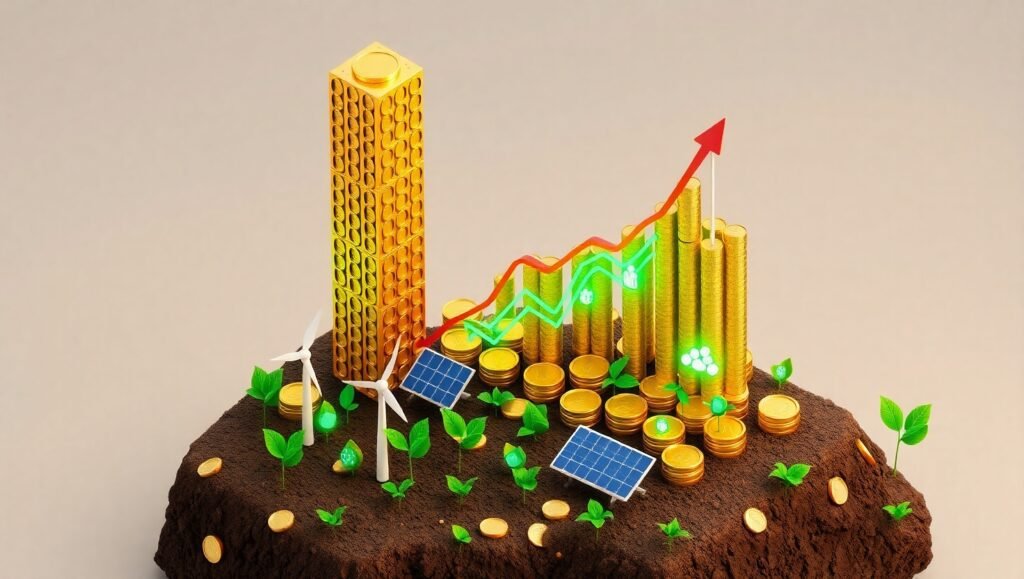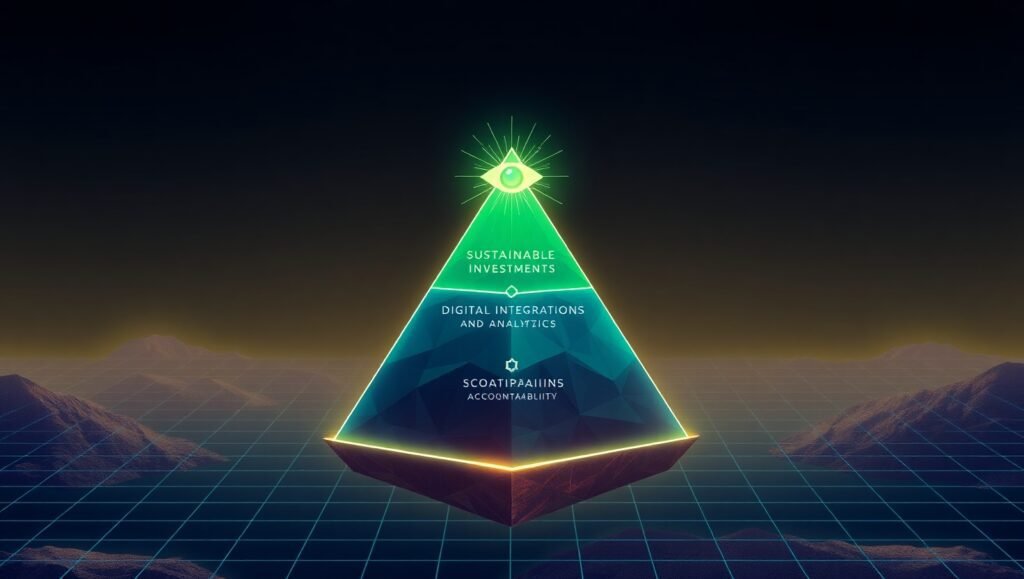Ecomoney Integration Blueprint: 10 Game-Changing Tactics for Sustainable Profit & Eco-Future

Integrating Ecomoney into Existing Systems: Revolutionary 10 Strategies – Learn essential steps to adopt Ecomoney, a sustainable finance model blending eco-friendly practices with digital innovation.
In our rapidly changing world, modernizing financial systems is crucial for a sustainable tomorrow. Ecomoney is a groundbreaking approach that merges green practices with advanced digital tech, creating opportunities to make money while caring for our environment.
This article details 10 revolutionary strategies to integrate Ecomoney into your current systems, ensuring a secure, transparent, and eco-friendly economic future.
Introduction to Ecomoney and Its Importance
Modern economies face unprecedented challenges, from climate change to resource scarcity, making it essential to rethink how we handle money.
Ecomoney offers a solution by fusing eco-friendly methods with state-of-the-art digital technology, creating a financial system that’s as green as it is profitable.

Traditional financial models often prioritize quick returns, neglecting the environmental costs of economic activities.
In contrast, Ecomoney shifts the focus toward long-term stability and sustainability. By integrating digital innovations like blockchain and AI, it ensures that every financial transaction is secure, transparent, and aligned with eco-friendly goals.
This transformative approach not only boosts economic growth but also protects natural resources. Businesses, communities, and governments can all benefit from Ecomoney by investing in renewable energy, green infrastructure, and other sustainable initiatives.
In essence, Ecomoney paves the way for a future where economic success and environmental care go hand in hand.
Why Ecomoney Matters
Ecomoney is more than just a new buzzword—it’s a practical model that addresses two critical needs: economic stability and environmental protection.
Economic Stability and Growth
Ecomoney supports a robust financial system by emphasizing long-term investments in sustainable projects. Instead of chasing short-term gains, it encourages investments that offer steady returns over time.

This strategy helps build an economy resilient to market fluctuations, ensuring that businesses thrive even in uncertain times.
Moreover, sustainable investments often unlock new market opportunities. As consumers increasingly favor eco-friendly products, companies that adopt Ecomoney practices are more likely to gain a competitive advantage.
This not only attracts investors but also enhances customer loyalty, ultimately driving growth and stability.
Environmental and Social Benefits
On the environmental front, Ecomoney focuses on reducing carbon footprints and promoting renewable energy sources.
By investing in green projects, businesses contribute to cleaner air, improved energy efficiency, and reduced resource waste.

This positive impact on the environment also translates into social benefits, such as healthier communities and increased job opportunities in sustainable industries.
Transparency is another key benefit. Digital tools like blockchain ensure that every transaction is documented and verifiable, building trust among all stakeholders. This level of openness helps prevent fraud and promotes accountability, crucial in today’s digital age.
Ecomoney, therefore, is a holistic approach that benefits not only the economy but also the environment and society as a whole. It’s about creating a win-win situation where financial success supports sustainable practices and vice versa.
Defining Ecomoney: Core Principles and Concepts
Understanding Ecomoney begins with grasping its core principles. At its essence, Ecomoney combines smart, sustainable investment strategies with advanced digital technology to create an integrated financial system.

Sustainable Investments
At the heart of Ecomoney is the idea that every investment should serve dual purposes: generate profits and foster environmental well-being.
This means prioritizing projects that promote renewable energy, reduce waste, or support sustainable practices.
Instead of merely chasing quick returns, Ecomoney encourages long-term commitments that contribute to the overall health of our planet.
Digital Integration and Transparency
A modern financial system needs robust digital support. Ecomoney leverages blockchain technology to ensure that all transactions are secure and transparent.
Blockchain’s immutable ledger means that every dollar is tracked, building trust among investors and stakeholders.
Additionally, AI-driven analytics provide real-time insights into performance, enabling informed decisions and timely adjustments.
Accountability
Clear, transparent reporting is crucial for any financial model. Ecomoney emphasizes accountability by setting up systems where every transaction is recorded and its impact measured.
This not only reassures investors but also aligns with global standards of responsible finance.
Together, these principles form the foundation of Ecomoney. They allow businesses and communities to embrace a financial model that is forward-thinking, resilient, and eco-conscious.
Setting Clear Goals and Crafting a Vision
Before integrating Ecomoney, it’s essential to outline your objectives and create a clear vision that guides your efforts.

Establishing Financial, Environmental, and Social Objectives
Start by defining what you hope to achieve. Your goals should cover three primary areas:
- Financial Objectives: Determine your revenue targets and desired returns. Consider how sustainable investments will generate steady, long-term income.
- Environmental Objectives: Outline specific targets such as reducing carbon emissions, improving energy efficiency, or increasing the share of renewable energy in your operations.
- Social Objectives: Think about the community impact—job creation, improved quality of life, and enhanced social equity are key aspects.
Clearly defined objectives act as a roadmap, ensuring that every decision and investment aligns with your overarching goals.
Crafting a Compelling Vision Statement
Your vision is the driving force behind your initiative. It should encapsulate your commitment to both profitability and sustainability.
A well-crafted vision statement might read: “To build a resilient financial ecosystem that fuels economic growth while safeguarding our environment for future generations.”
This statement serves as a guiding light for your team and reassures stakeholders that your efforts have a meaningful, long-term purpose.
Aligning Strategies with Goals
Once your objectives and vision are set, translate them into actionable strategies. This involves:
- Prioritizing Projects: Focus on initiatives that offer maximum impact both financially and environmentally.
- Resource Allocation: Determine how best to distribute your financial, technological, and human resources.
- Setting Performance Metrics: Establish clear KPIs to measure progress. Metrics might include ROI, emission reductions, energy savings, and social impact indicators.
By aligning strategies with your goals, you create a structured path forward that is both measurable and achievable.
Conducting In-Depth Market Research
Successful integration of Ecomoney starts with thorough market research. Understanding current trends, consumer behavior, and regulatory environments is vital for shaping a strategy that works in today’s market.

Analyzing Trends in Green Finance and Technology
Begin by exploring the latest developments in green finance. Research industry reports and insights from reputable sources like Investopedia to understand the movement toward sustainable investments. Look into:
- Investment Flows: How are funds being redirected toward eco-friendly projects?
- Technological Innovations: What role do technologies like blockchain and AI play in modern finance?
- Market Forecasts: What are the predicted trends for green finance over the next few years?
Evaluating the Regulatory Environment
Understanding the legal landscape is crucial. This involves:
- Studying Local and National Policies: Identify incentives, tax breaks, and subsidies available for green investments.
- Compliance Requirements: Ensure your project will meet all necessary regulatory standards to avoid legal pitfalls.
- Engaging with Policymakers: Building relationships with regulators can provide early insights into upcoming changes that may affect your strategy.
Feasibility and Risk Analysis
A comprehensive feasibility study should include:
- Cost-Benefit Analysis: Weigh the potential returns against the costs of implementation, including technological and regulatory expenses.
- Risk Assessment: Identify risks such as market volatility, technological hurdles, or changes in regulatory policies, and develop mitigation strategies.
- Stakeholder Input: Consult with industry experts, potential investors, and community leaders to validate your approach.
This research lays the foundation for a robust and adaptable Ecomoney strategy that is well-suited to current market conditions.
Designing a Robust Ecomoney System
With clear goals and market insights in hand, the next step is to design a system that integrates Ecomoney seamlessly into existing structures.
This involves creating both a digital framework and a financial blueprint that are secure, efficient, and sustainable.

Building a Digital Framework with Blockchain and AI
The digital backbone of Ecomoney must be both secure and adaptable. Key components include:
- Blockchain Technology: By recording every transaction on a decentralized ledger, blockchain ensures transparency and security. This immutable record helps build trust and prevents fraud.
- AI-Powered Analytics: Using artificial intelligence to monitor system performance in real time allows for quick adjustments and informed decision-making. These tools can analyze transaction data, track trends, and highlight potential issues.
- Interoperability: Ensure your new system can easily integrate with existing financial platforms. This minimizes friction and simplifies adoption for all users.
Implementing a robust digital framework is essential for maintaining the integrity and efficiency of your Ecomoney system.
Developing a Sustainable Financial Blueprint
Your financial blueprint should detail how investments will be managed and how returns will be generated in a sustainable manner. Consider these aspects:
- Defining Investment Criteria: Establish what makes an investment “sustainable.” Criteria might include low carbon emissions, renewable energy usage, and positive social impact.
- Creating Incentive Structures: Design incentives to encourage investment in eco-friendly projects. Options could include tax incentives, green bonds, or digital rewards that align with your sustainability goals.
- Ensuring Transparent Reporting: Develop clear reporting protocols that provide stakeholders with regular updates on financial performance and sustainability outcomes. Transparency is key to building confidence and ensuring accountability.
By creating a comprehensive financial blueprint, you ensure that every dollar invested contributes to a sustainable future.
Integration and Synergy
Finally, ensure that all components of your digital and financial system work in harmony.
The goal is to create a seamless ecosystem where technology and finance support each other, leading to an efficient, resilient, and sustainable model.
Building Infrastructure and Ensuring Compliance
For Ecomoney to function effectively, it must be supported by robust infrastructure and adhere strictly to regulatory standards.
This section outlines the steps to build a secure, scalable system that meets all legal requirements.

Developing a Scalable Digital Infrastructure
Invest in the foundational elements that will support your Ecomoney system:
- High-Security Servers: Utilize advanced servers and data centers capable of handling large volumes of transactions securely.
- Scalable Technology: Build your system on platforms that can grow as your user base expands. Scalability is crucial to accommodate future growth without performance issues.
- User-Friendly Interfaces: Design intuitive interfaces that make it easy for users—from tech-savvy investors to everyday consumers—to interact with the system. Simplicity and accessibility are key to wide adoption.
A solid infrastructure ensures your system remains reliable, secure, and capable of evolving over time.
Meeting Legal and Regulatory Standards
Compliance is a must in any financial system. Ensure your project meets all legal requirements by:
- Securing Necessary Licenses: Obtain all required certifications and licenses from regulatory bodies. This step builds credibility and ensures legal protection.
- Conducting Regular Audits: Schedule periodic audits to verify that your system complies with industry standards and regulations. Regular checks help identify areas for improvement.
- Implementing Transparent Practices: Adopt clear reporting methods that make it easy for regulators and stakeholders to review financial data and sustainability outcomes.
External Collaboration for Compliance
Sometimes, working with established institutions can ease the compliance process. Partner with financial institutions or certification agencies that specialize in sustainable finance to gain additional insights and support.
This robust approach to infrastructure and compliance lays a secure foundation for Ecomoney, ensuring long-term success and trust among all stakeholders.
Engaging Stakeholders and Forming Strategic Partnerships
No project can succeed in isolation. Engaging key stakeholders and forming strategic partnerships is vital to the successful adoption of Ecomoney.
This section explains how to build a supportive network that drives your initiative forward.

Identifying Key Investors and Partners
Start by identifying the key players in your ecosystem. Look for:
- Investors: Venture capitalists, banks, and angel investors who are passionate about sustainable finance.
- Government Agencies: Local, state, and federal bodies that offer incentives for green projects.
- Community Organizations: Local groups that can help ensure your system addresses community needs and promotes social inclusion.
Mapping out these stakeholders provides a clear picture of who can contribute to and benefit from your Ecomoney project.
Building Strategic Alliances
Once you’ve identified potential partners, focus on developing long-term relationships that offer mutual benefits. Effective strategies include:
- Hosting Collaborative Workshops: Organize roundtables and workshops where stakeholders can exchange ideas and build trust.
- Sharing Resources: Pool technological, financial, and market expertise to create a stronger, more unified initiative.
- Ensuring Mutual Benefits: Structure partnerships so that every party gains—whether through financial returns, improved technology, or enhanced social impact.
Strategic alliances can significantly accelerate the integration of Ecomoney, ensuring a collaborative approach that benefits everyone involved.
Developing an Implementation Roadmap and Pilot Program
A detailed implementation roadmap is critical to the success of your Ecomoney integration.
This plan outlines the step-by-step process from initial development to full-scale deployment.

Crafting a Detailed Roadmap
Your roadmap should serve as a blueprint for the project, including:
- Clear Milestones: Identify key phases such as planning, system development, pilot testing, and full-scale rollout.
- Realistic Timelines: Set achievable deadlines for each phase to ensure steady progress.
- Responsibilities: Define who is responsible for each task, promoting accountability across your team.
A well-structured roadmap keeps everyone on track and clarifies the path to success.
Running a Pilot Program
Before rolling out the system broadly, test it on a smaller scale. The pilot phase should involve:
- Controlled Deployment: Launch the Ecomoney system in a limited environment to monitor performance.
- Collecting User Feedback: Gather insights from early users to identify strengths and areas needing improvement.
- Data-Driven Adjustments: Use analytics to evaluate key performance indicators like transaction speed and user satisfaction.
The pilot phase allows you to refine your system before full-scale implementation, reducing risks and ensuring a smoother transition.
Full-Scale Deployment and Continuous Monitoring
After a successful pilot, it’s time to expand the system to a broader audience. This phase requires careful management to maintain quality and ensure ongoing optimization.
Phased Rollout and Training
Adopt a gradual expansion strategy by:
- Step-by-Step Deployment: Increase user numbers and geographic coverage gradually to manage any unforeseen issues.
- Comprehensive Training: Provide training sessions and user guides to help everyone adapt to the new system.
- Targeted Marketing: Roll out marketing campaigns that clearly communicate the benefits of Ecomoney, attracting a diverse range of users and investors.
Ongoing Monitoring and Optimization
Continuous improvement is essential for long-term success. Maintain the system by:
- Using Real-Time Dashboards: Monitor key metrics in real time to quickly identify and address issues.
- Conducting Regular Audits: Schedule frequent audits to ensure compliance, security, and operational efficiency.
- Collecting User Feedback: Regularly survey users and stakeholders to gather insights for further enhancements.
This ongoing monitoring ensures that your Ecomoney system remains adaptive, efficient, and responsive to market changes.
Embracing Continuous Improvement and Innovation
The journey doesn’t end with deployment; continuous improvement is key to staying competitive and sustainable.
Embrace innovation by regularly updating your systems and strategies.
Investing in Research and Development
Innovation drives progress. To keep your Ecomoney system at the forefront, consider:
- Collaborative Projects: Partner with universities, research institutions, and tech startups to explore new advancements.
- Innovation Hubs: Create internal teams dedicated to continuous improvement and creative problem-solving.
- Regular Upgrades: Stay informed about new technologies and update your digital infrastructure accordingly.

Adapting to Future Changes
The market and environmental conditions are always evolving. Prepare for the future by:
- Scalability: Design your system so it can grow effortlessly as demand increases.
- Resilience: Build robust backup and security measures to protect against cyber threats and economic downturns.
- Flexibility: Be ready to adjust strategies and adopt new technologies as they emerge, ensuring your system remains relevant.
A culture of continuous improvement not only safeguards your investment but also positions your Ecomoney system for long-term success.
Conclusion: The Future Impact of Ecomoney Integration
Integrating Ecomoney into existing systems represents a transformative step toward a sustainable financial future.
By adopting these revolutionary 10 strategies, businesses and communities can build a financial ecosystem that harmonizes profit with environmental stewardship.
Ecomoney not only drives long-term economic stability but also promotes investments that reduce carbon footprints and improve resource management. With robust digital infrastructure, transparent reporting, and strategic partnerships, this model sets the stage for a resilient, future-proof economy.
As we continue to face environmental and economic challenges, the adoption of Ecomoney will become increasingly essential.
It offers a path to sustainable growth that benefits investors, businesses, and society alike. Embrace this innovative approach, and you’ll not only secure your financial future but also contribute to a healthier, greener planet.


